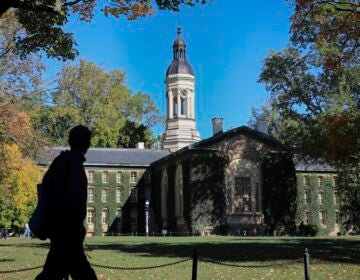Amusement park plan to cut down trees for a solar farm called ‘ridiculous’

It was a conflicted Earth Day for New Jersey’s environmental activists, who took the occasion to criticize something usually dear to their hearts: solar power.
“Trying to say that taking this forest away and replacing it with solar panels is good for the planet is the most ridiculous thing I’ve heard in 35 years as a scientist,” fumed Emile DeVito of the New Jersey Conservation Foundation, standing on a road near the edge of the Six Flags Great Adventure amusement park in Jackson Township.
Six Flags plans to cut down 18,000 trees on 90 acres for one of the most ambitious renewable-energy projects yet: a 21.9-megawatt solar array that on most summer days will make the park energy independent.
Working with KDC Solar LLC of Bedminster, Six Flags says the installation will deliver the equivalent energy needed to power 3,100 homes without the carbon emissions of fossil fuel sources. That’s equal to about 230,000 tons of carbon over 15 years — a net bargain in exchange for 9,600 tons of carbon the trees would remove from the air in those years, the company claims.
But achieving that goal means cutting out a chunk of forest at the edge of the Pine Barrens that already captures carbon and has an important role in filtering water that goes east and west, to Barnegat Bay and the Delaware River, said Britta Forsberg Wenzel of the group Save Barnegat Bay.
“This is something that rises to the level of statewide and regional ecosystems,” said former Gov. James J. Florio, who as a congressman in the 1970s sponsored federal legislation that enabled preservation of the Pinelands — the forest-area zone that Six Flags lies just outside, thanks to political compromises that set aside some lands for development.
Instead, environmental groups want Six Flags to use its parking areas for solar power — mounting solar panels in cantilevered panels above parking spaces, like the massive 28-acre, 8-megawatt solar carports at Rutgers University, now the largest such installation in the nation.
“We strongly support solar power. This could be a landmark example of a solar success story by using the park’s mammoth parking lots. Instead it’s a tale of a company choosing to chop down 90 acres of forest when they don’t need to,” said Doug O’Malley of Environment New Jersey.
Six Flags president John Fitzgerald said company officials considered the parking-lot alternative, but need all the space they have now for parking and special events, and possible future expansion.
Then they worried about safety, with visitors walking among humming direct-current inverters collecting electricity from the panels.
“Tens of thousands of visitors come to Six Flags every day and use the parking lot, including many children and young adults. It would be imprudent to allow park visitors access to solar arrays set over such a large and widespread area,” Fitzgerald said in a prepared statement.
Upfront costs are a big factor too for Six Flags. With the cost of steel pylons and construction, parking-lot solar panel projects can cost between 20 percent and 50 percent more than a ground-level installation in an open field, according to industry sources.
Carport solar can make sense in a densely built environment, like a corporate or college campus where available roof space is already dedicated to solar and managers want to boost their energy production.
Beyond construction costs, there are other considerations for parking -ot solar. Just south in Atlantic County, Stockton University in 2009 built what at the time was the nation’s biggest solar carport project, an 852-kilowatt array sheltering the main student residential parking lot — part of the university’s overall 1.2 megawatts of solar power.
“You can only do it in a parking lot where you have a lot of control” over traffic, said Alice Gitchell, energy planner for Stockton’s building department. That means cars-only, she said; once a truck driver blundered into a Stockton lot through the wrong driveway and knocked a panel askew.
Other than that, Stockton’s solar panels don’t give a lot of operational trouble for the university or its private-sector partners who actually own and operate the systems, Gitchell said. Financially, it’s been a different story for the operators, who took a hit when the subsidized prices of solar took a dive in recent years.
New Jersey’s use of Solar Renewable Energy Credits, or SRECs, is one subsidy that has encouraged construction of solar carports. One credit represents 1,000 kilowatt-hours that utilities can buy to fulfill obligations to meeting renewable energy goals. SREC prices were depressed during the recession but have been coming back.
At the outset of Stockton’s renewables development, SRECs hit $700 but are now around $280 even with the modest rebound, Gitchell said.
At nearby Atlantic Cape Community College, the age of the roofs of buildings and the upgrades needed before deploying solar made carports an economical decision, said Richard Perniciaro, vice president of planning, research and facilities for the college. The price tag for improving about one-third of the roofs to support solar panels during their 15- to 20-year lifespan actually made it cheaper to go with the carport arrays, he said.
Commercial projects now generate nearly 1 million kilowatts or about 70 percent of solar power in New Jersey.
___________________________________________________
NJ Spotlight, an independent online news service on issues critical to New Jersey, makes its in-depth reporting available to NewsWorks.
WHYY is your source for fact-based, in-depth journalism and information. As a nonprofit organization, we rely on financial support from readers like you. Please give today.




